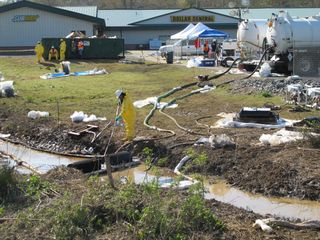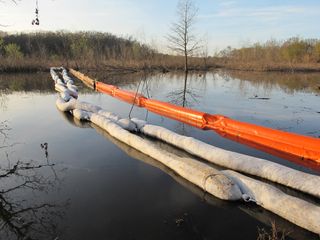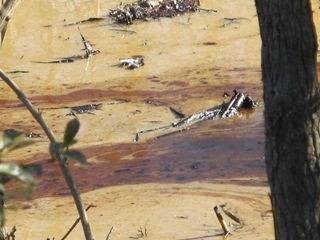
Arkansans Still Suffering Effects from Seeping Oil Months After Mayflower Spill (Op-Ed)

Rocky Kistner is a communications associate for the NRDC. This post is adapted from one that appeared on the NRDC blog Switchboard. Kistner contributed this article to LiveScience's Expert Voices: Op-Ed & Insights.
It's been a warm, rain-soaked summer in the small lakeside community of Mayflower, a sleepy residential town north of Little Rock, Ark., famous its bluegill and bass fishing in nearby Lake Conway.
But for some folks here, the rain has brought an unpleasant reminder that Mayflower is not the same picture-postcard community it once was. Instead, its residents say they are still suffering health effects from an estimated 5,000 barrels of tar-sands crude oil that burst from an ExxonMobil pipeline on March 29th and poured through a residential neighborhood. The black, viscous oil then flowed into culverts and a creek by the town shopping center, finally draining into a marshy area of the lake where much of it remains buried in sediment. Residents say heavy rains cause the oil to leak out into a cove that drains into Lake Conway.

Although locals say cleanup work in the marshy cove has dropped off significantly, they say they can still smell the sickly sweet odor of crude after it rains. Some still complain of health problems like headaches, nausea and vomiting that have plagued families near the cove since the end of March.
"I'm still having problems breathing," says Sherry Appleman, who lives near the oil-soaked cove on the lake and lost her husband to cancer in June, a condition she believes was made worse by the poisonous spill five months ago. She says she's battled headaches and asthma-like conditions since the tarry crude invaded her once-pristine Arkansas lakeside environment five months ago. "Our health conditions have gotten worse, people with cancer have gotten worse instead of getting better….the local health department says everything's normal, but they're just saying what Exxon wants them to say."

Although state authorities say the oil has not gotten into the main body of Lake Conway, Appleman — like many who live on the lake — believe it has. She says she's seen oil-contaminated water in ditches that drain from the contaminated cove area and empty into the lake. "The oil has to be in the lake, everyone knows it is, there's no way they can keep it from out of the lake with the flash floods we've had recently."
Louisiana-based toxicologist and chemist Wilma Subra — who has studied health exposures from the BP oil spill — has been following health problems in Mayflower that continue to plague residents. She says rainfall can cause oil to float to the surface, where volatile and toxic chemicals can off-gas into the air. "Rainfall events can cause the crude oil to float to the surface and cause health effects, it's typical of what can occur at waste sites like these," Subra says. "They should have evacuated more of the population to stop the exposure."
Sign up for the Live Science daily newsletter now
Get the world’s most fascinating discoveries delivered straight to your inbox.

State and federal agencies that monitor air and water contaminants around the spill say the environment is safe, although more testing continues. But many locals don't believe it. For Genieve Long, a mother of four young children who lives near the oily cove, it's been a recurring nightmare of health problems since the black goo settled in the marsh area nearby. Long says conditions near the site have continued to make her family sick.
"We've had vomiting, abdominal pain, migraines and respiratory problems. My five-year old has fevers and joint pain. The doctors have done blood tests but don't know what's going on … Exxon has refused to pay medical claims because they say the air quality is fine."
That's also a problem for people who live near the source of the spill less than a mile from the lake, where Exxon's Pegasus pipeline ruptured and poured out of a 22-foot gash near the Northwoods subdivision, causing a gusher of Canadian tar-sands oil that flowed through the suburban neighborhood.

Ann Jarrell lives about 350 yards from blowout site behind Northwoods. She complains of ongoing health problems, including headaches, nausea and respiratory ailments, and says her daughter suffered seizure-like conditions after cutting the grass, while her grandson has been put on an inhaler. Jarrell says her doctor has told her not to return to her house because of the health problems they continue to experience; when Jarrell spoke to a doctor with the Arkansas health department, she reports she was referred back to her primary physician.
"We need help and we're being ignored," Jarrell says. "They should have evacuated a larger area…I've never been so sick. When my doctor told me don't go back to the house, my friends picked up my clothes and medicine and my dog."
Jarrell says she's not sure what to do now. Although she considers herself lucky to be able to stay with a friend, she says she can't afford to buy another place. "I can't sell my house when there's a big pipeline sign right by my house."
Recent reports of health complaints have been highlighted in a collaborative series of stories by the Arkansas Times and InsideClimate News, but most news pieces have largely ignored the health problems, including a recent New York Times report about tar-sands spills in Mayflower and along Michigan's Kalamazoo River three years ago.
But locals, like April Lane of the Faulkner County Citizens Advisory Group, say they will keep pushing officials for greater health information and analysis, pressing political leaders and rallying members of the community for increased resources and support. "We need expert doctors to come here and study what are the actual effects in the community," Lane says, who is advocating for a health survey of local complaints. "Remediation is not sufficient. They're just burying the oil and leaving it in the cove. The compounds are evaporating into the atmosphere and we are seeing people with recurring exposures."
Lane and others are helping organize another town hall meeting in nearby Maumelle on Saturday Aug. 31. It will be attended by many of the same residents who came together in the first community meeting four months ago, people still suffering from health symptoms and nagging questions about the torrent of toxic tar-sands oil that poured out of the ground and embedded in their community, changing their lives in ways they never imagined.
This article was adapted from Health Problems Still Plague Arkansas Residents Near ExxonMobil Tar Sands Spill on the NRDC blog Switchboard. The views expressed are those of the author and do not necessarily reflect the views of the publisher. This article was originally published on LiveScience.
Most Popular


